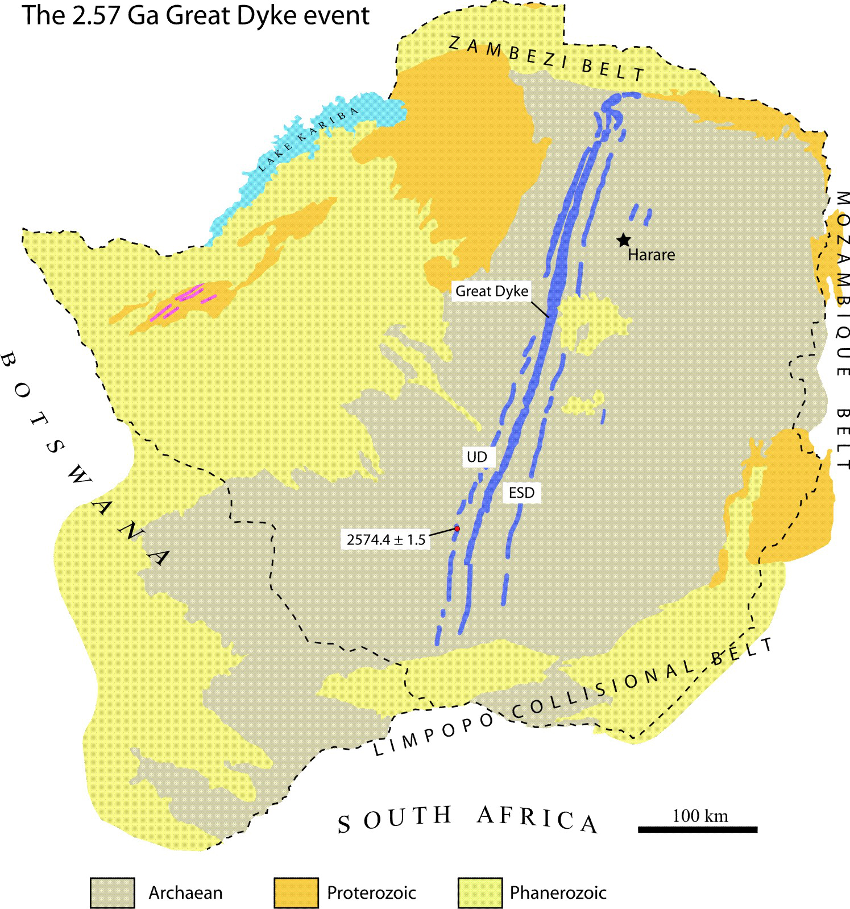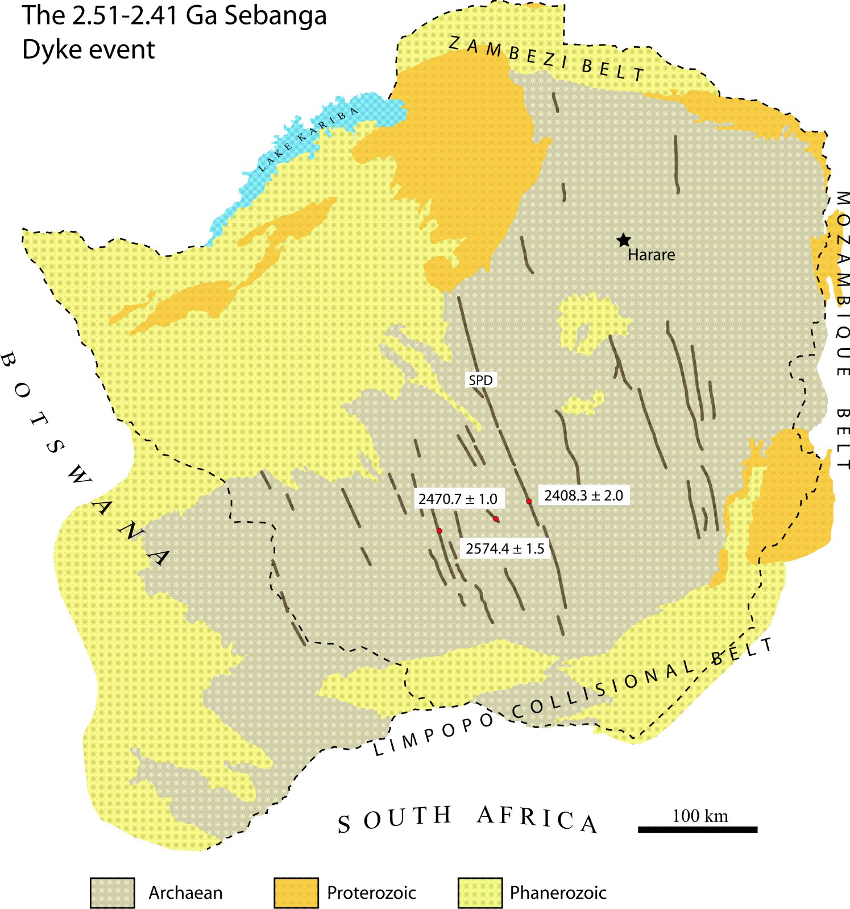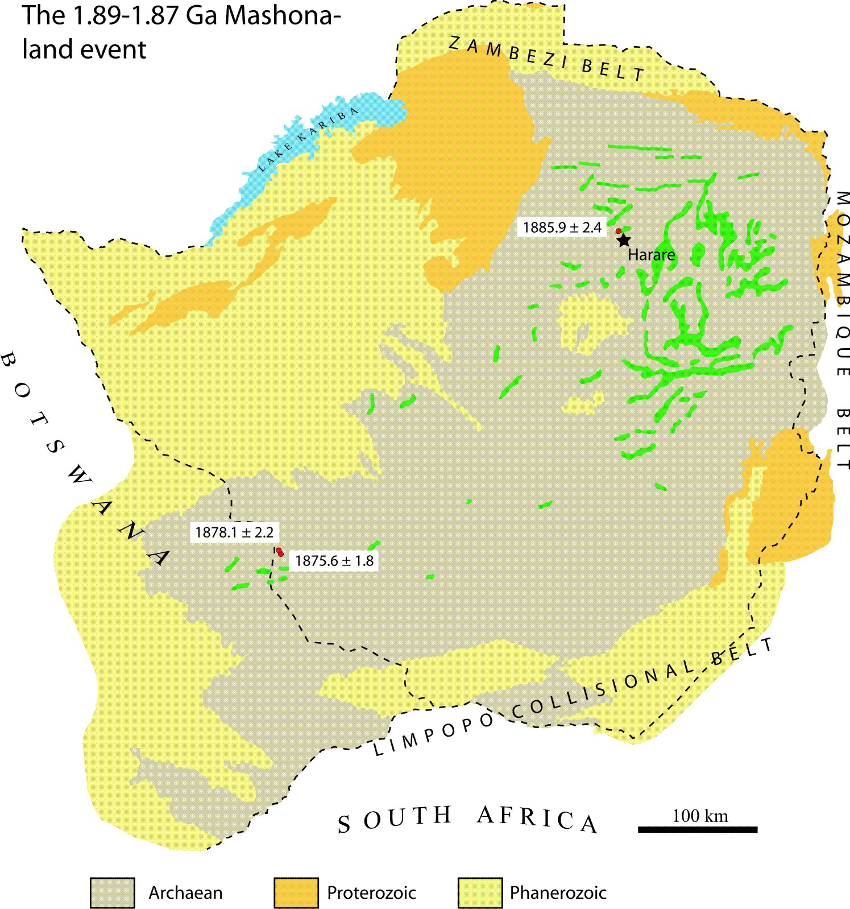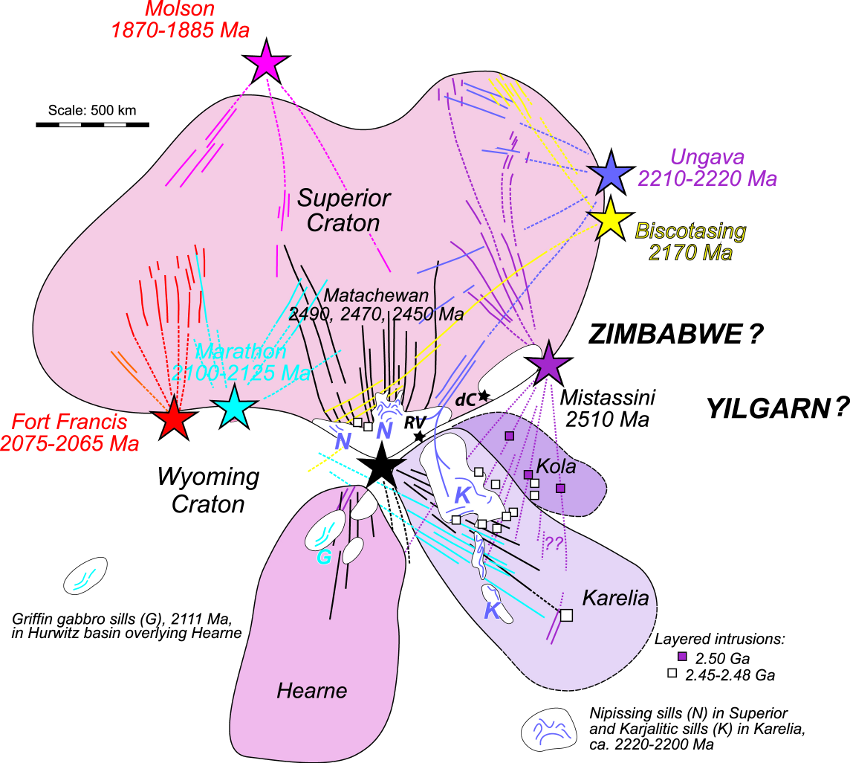December 2009 LIP of the Month
Regional-scale 2.6-1.9 Ga Large Igneous Provinces of Zimbabwe
Authors: Ulf Söderlund a, Axel Hofmann b, Martin B. Klausen b, Johan R. Olsson a, Richard E. Ernst c, Per-Olof Persson d
Affiliations: aDepartment of Geology, GeoBiosphere Science Centre, Lund University, Sölvegatan 12, SE-223 62 Lund, Sweden. bSchool of Geological Sciences, University of KwaZulu-Natal, Private Bag X 54001, Durban, South Africa. cErnst Geosciences, 43 Margrave Ave., Ottawa, Canada K1T 3Y2, and Carleton University, Ottawa, Canada K1S 5B6. dLaboratory of Isotope Geology, Swedish Museum of Natural History, Box 50007, SE-104 05 Stockholm, Sweden.
E-mail: ulf.soderlund@geol.lu.se
The granite-greenstone terrain of the Zimbabwe craton makes up a significant portion of the world’s total Archaean crust, and is also the host of many mafic dyke swarms and sill complexes whose emplacement ages, with the exception of the 2575 Ma Great Dyke and its satellite dykes, are poorly known. Here, a summary U-Pb baddeleyite dates and distributions of the Great Dyke, the Sebanga and the Mashonaland events are extracted from Söderlund et al. (in press), and illustrated in separate maps [Fig. 1-3; modified from Stubbs et al. (1999) and Wilson et al. (1987)].

Figure 1: Distribution of Great Dyke of Zimbabwe and its satellite dykes. New precise age from Soderlund et al. (in press) on the Umvimeela satellite dyke is shown.

Figure 2: Distribution of Sebange dykes which are now known to consist of at least three distinct Paleoproteozoic ages (Soderlund et al., in press). SPD = Sebanga Poort Dyke.

Figure 3: Distribution of Mashonaland LIP with locations of new precise ages from Söderlund et al. (in press).
The Great Dyke of Zimbabwe is the world’s largest dyke-like layered intrusion (Fig. 1). The 2575.0 ± 1.5 Ma age obtained from the neighbouring Umvimeela dyke is indistinguishable from the 2575.4 ± 0.7 Ma result [Oberthür et al., 2002] for a pyroxenite layer of the Great Dyke and testifies to synchronous emplacement of the Great Dyke of Zimbabwe and its satellites.
The NNW-trending dykes of the Sebanga swarm are found over the entire exposed craton and cover an area at least 500 km wide and 350 km long (Wilson et al., 1987; Fig. 2). The dykes are widely spaced and largely parallel, with no indication of any radiating pattern. U-Pb dates of 2408.3±2.0 Ma (ZM7-7, the Sebanga Poort Dyke), 2470.0±1.2 Ma (ZM7-10, the Mtshingwe Dolerite) and 2512.3 ± 1.8 Ma (BCD5-48, the Crystal Springs dyke) indicate at least three separate generations of the Sebanga dyke swarm.
The Proterozoic Mashonaland sills crop out throughout the Zimbabwe craton but are concentrated in its northeast quarter, and are intrusive into basement granites and greenstone belts as well as the Great Dyke and its satellites (Fig. 3). Crystallisation ages of 1877 ± 2.2 Ma, 1885.9 ± 2.4 Ma and 1875.6 ± 1.6 Ma were obtained for three dolerite samples of the extensive Mashonaland sills from different parts of the Zimbabwe craton.

Figure 4: Barcode record of a number of Archaean cratons selected for potential relevance to the Zimbabwe craton. Arrows depicts possible age matches of mafic intrusions between cratons. The record reveals three post-2.0 Ga magmatic events common to both the Zimbabwe and Kaapvaal cratons, while no matches occur in pre-2.0 Ga times, in favour of formation of Kalahari at ca. 2.0 Ga. Note matches of mafic intrusions between crustal blocks at 1.88, 2.41, 2.47, and 2.51 Ga. BLIP = Baltic Large Igneous Province. References for ages are given in Söderlund et al. (in press).

Figure 5: Proposed Paleoproterozoic reconstruction of Superior, Kola-Karelia, Hearne and Wyoming cratons using the LIP barcode record (modified after Bleeker and Ernst, 2006). The Zimbabwe craton is tentatively placed east of the Superior craton and north of the Kola-Karelia block on the basis of several links between Sebanga dykes and coeval dyke swarms in the eastern part of the Superior craton. The Yilgarn craton is tentatively placed close to the Zimbabwe craton on the basis of similar ages for the Widgiemooltha swarm and the Sebanga Poort Dyke. Abbreviations RV and dC depict the 2475 ± 2 Ma River Valley intrusion and the 2408 ± 2 Ma du Chef swarm, respectively.
Figure 4 shows magmatic activity which is present in both Zimbabwe and Kaapvaal cratons at ca. 0.18 Ga (Jourdan et al., 2006), at ca. 1.1 Ga (Hanson et al., 2004a) and at ca. 1.9 Ga (Hanson et al., 2004b; Olsson et al., unpubl. data; Söderlund et al., in press), of which the latter indicates the oldest identified magmatic age for the Kalahari Craton, the time when Zimbabwe and Kaapvaal formed a coherent block. The absence of magmatism during Bushveld times (2.06 Ga) in the Zimbabwe craton and the corresponding absence of Great Dyke (2.57 Ga) and Sebanga dyke ages (2.51 Ga, 2.47 Ga and 2.41 Ga) in the Kaapvaal craton, imply that the Kaapvaal and Zimbabwe cratons were dispersed during the early Palaeoproterozoic. The barcode record together with geochronological and petrological constraints suggests unequivocally that Kaapvaal and Zimbabwe did not merge into a coherent block (Kalahari) until ca. 2.0-1.9 Ga.
The 2512 Ma, 2470 Ma and 2408 Ma baddeleyite U-Pb ages of WNW- to NNE-trending Sebanga dykes are of major significance in that they exactly match events of major LIPs in blocks that formed the proposed supercraton Superia (Bleeker 2003) in the late Archaean to early Palaeoproterozoic (Fig. 4). Detailed documentation of these matches is given in Söderlund et al. (in press). We suggest that Zimbabwe was part of Superia at the time of these events (Fig. 5), possibly adjacent to the Kola-Karelia block and at the east side of the Superior craton in the proposed reconstruc tion of Bleeker and Ernst (2006). The 2408.3 ± 2.0 Ma result for the Sebanga Poort Dyke additionally provides a link to the Yilgarn craton in Western Australia, especially considering that this age is relatively rare in the global dyke record.
In addition to the herein investigated dyke swarms and sill complexes there are a number of other Precambrian dyke swarms such as the Mashaba-Chibi, Plumtree, Guruve and Kamative dykes. Acquiring robust emplacement ages for these swarms, as well as for LIPs in cratons that once may have been adjacent to the Zimbabwe craton in Proterozoic and Archean times, are necessary to establish confident paleocontinental reconstruction (see www.supercontinent.org).
Click to open/close References References
Bleeker, W., 2003. The late Archean record: A puzzle in ca. 35 pieces. Lithos 71, 99-134.
Bleeker, W., Ernst, R.E., 2006. Short-lived mantle generated magmatic events and their dike swarms: The key unlocking Earth’s paleogeographic record back to 2.6 Ga. In: Hanski, E., Mertanen, S., Rämö, T., and Vuollo, J., eds., Dike Swarms: Time Markers of Crustal Evolution: Taylor & Francis/Balkema, Leiden, p. 3-26.
Hanson, R.E., Crowley, J.L., Bowring, S.A., Ramezani, J., Gose, W.A., Dalziel, I.W.D., Pancake, J.A., Seidel, E.K., Blenkinsop, T.G., Mukwakwami, J., 2004. Coeval large-scale magmatism in the Kalahari and Laurentian cratons during Rodinia assembly. Science 304, 1126-1129.
Hanson, R.E., Gose, W.A., Crowley, J.L., Ramezani, J., Bowring, S.A., Bullen, D.S., Hall, R.P., Pancake, J.A., Mukwakwami, J., 2004. Paleoproterozoic intraplate magmatism and basin development on the Kaapvaal Craton: Age, palaeomagnetism and geochemistry of ~1.93 to ~1.87 Ga post-Waterberg dolerites. S. Afr. J. Geol. 107, 233-254.
Jourdan, F., Féraud, G., Bertrand, H., Watkeys, M.K., 2006. From flood basalts to the inception of oceanization: Example from the 40Ar/39Ar high-resolution picture of the Karoo large igneous province. Geochem., Geophys., Geosystems 8, DOI: 10.1029/2006GC001392.
Oberthür, T., Davis, D.W., Blenkinsop, T.G., Höhndorf, A., 2002. Precise U-Pb mineral ages, Rb-Sr and Sm-Nd systematics for the Great Dyke, Zimbabwe–constraints on late Archean events in the Zimbabwe craton and Limpopo belt. Precambrian Res. 113, 293-305.
Söderlund, U., Hofmann, A., Klausen, M.B., Olsson, J.R., Ernst, R., Persson, P.-O., in press. Towards a complete magmatic barcode for the Zimbabwe craton: Baddeleyite U-Pb dating of regional dolerite dyke swarms and sill complexes. Precambrian Research Special volume “High precision dating of Precambrian magmatic provinces, especially their dyke swarms”, in press.
Stubbs, H.M., Hall, R.P., Hughes, D.J., Nesbitt, R.W., 1999. Evidence for a high Mg andesitic parental magma to the East and West satellite dykes of the Great Dyke, Zimbabwe: a comparison with the continental tholeiitic Mashonaland sills. J. Afr. Earth Sci. 28, 325-336.
Wilson, J.F., Jones, D.L., Kramers, J.D.., 1987. Mafic dike swarms in Zimbabwe. In: Halls H.C. and Fahrig, W.F. (eds)Eds.), Mafic dike swarms. Geological Association of Canada, Special Paper 34, 433-444.